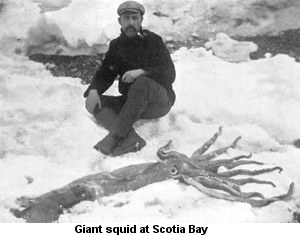
| Glasgow Digital Library | Voyage of the Scotia | BRUCE | PEOPLE | SHIP | ANTARCTIC | INDEX |
|---|
Robert Mossman (meteorologist) and William Smith (cook) had stayed behind with the Argentinians Szmula (meteorologist), Valette (naturalist) and a youth called Acuna (who came armed with a post office letter stamp, mail bag and books, such that he became known as the postmaster general) when Scotia sailed for home.

Meteorological and magnetic observations continued and were later compared with those of the French expedition to the west under Charcot.
The winter was not an easy time despite the new roof on Omond House. Before Scotia Bay was icebound, a storm threatened to destroy Omond House and one corner of the house collapsed. Considerable repair work was required involving the moving of 60 tons of boulders.
The weather was very cold and on 3 August the temperature was measured at -40şC. Temperatures inside Omond House were between 14şC to 16şC.
Bird and penguin migrations were recorded and over 100 penguins were killed for winter supplies. Fish such as rock cod were caught in large numbers. The beautiful sunsets in the South Orkney Islands were hard to describe: 'One small dome-shaped peak coruscated for some time like an enormous fiery opal, exhibiting a phatasmagoria of kaleidoscopic effects.'
In September the Weddell seals arrived to pup and the penguins arrived in their huge numbers. Fresh penguin eggs were soon on the menu. In December there was still ice in Scotia Bay, but Uruguay Cove to the north was open. On New Year's Eve 1904-05 the Argentinian relief ship Uruguay arrived.
| Glasgow Digital Library | Voyage of the Scotia | BRUCE | PEOPLE | SHIP | ANTARCTIC | INDEX |
|---|